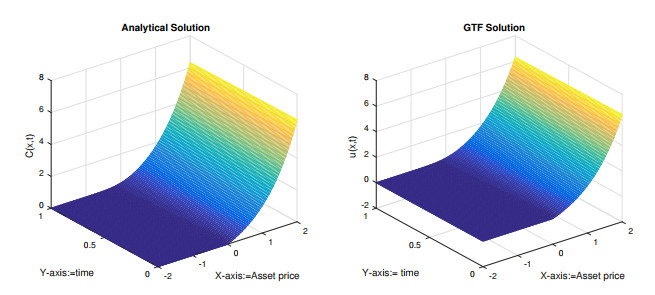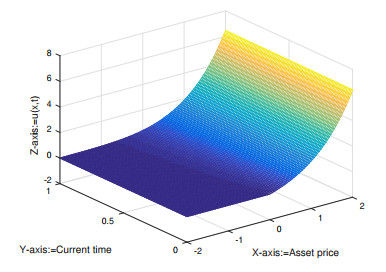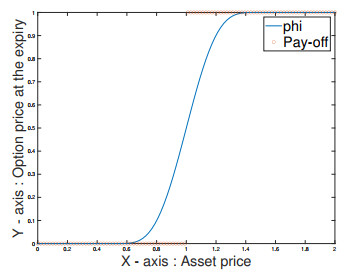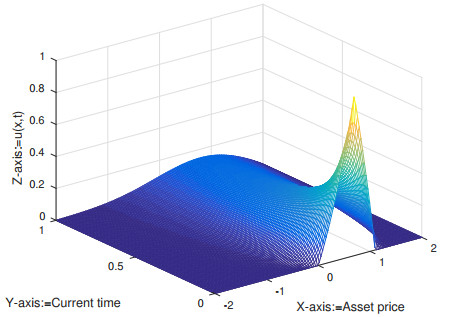Today industries related to finance are essentially implementing advanced mathematical tools. In 1973, Fisher Black and Myron Scholes developed an eminent stochastic model which later coined as Black-Scholes differential equations for option pricing. This paper illustrates a convenient time integration scheme based on the generalized trapezoidal formulas (GTF [α=13]) introduced by Chawla et al. in 1996. GTF is applied for the temporal discretization along with the classical finite difference schemes in space direction. The proposed scheme yields the (uniform) stability employing the uniform bound of the inverse operator, as well as second-order spatial accuracy and third-order temporal accuracy under reasonable conditions. Finally, the numerical illustrations and comparison with existing schemes demonstrate the stability and accuracy of the method.
1.
Introduction
Pricing of options is an amplified area of discussion among financial practitioners. An option is a bond between two parties in which the option buyer buys the right, not the obligation to buy or sell an underlying asset at a prefixed strike price from or to the option writer within a fixed period. According to the option rights, options are classified into Call and Put options. An option that brings the owner the right to buy at a specific price is known as a call; an option that brings the right of the owner to sell at a particular price is known as a put. Option styles are classified into American and European options. American options can be exercised at any time up to and including the expiry. European options can only be exercised on the day of expiration. Fischer Black and Myron Scholes [1,2] have given a mathematics model under the assumptions:
1. The change in stock price dS of the underlying satisfies the stochastic differential equation
where, μ is the drift rate, D is the dividend yield, σ is the market volatility and dW is the increment of a standard Wiener process.
2. The risk-free rate of return r, the drift μ, dividend yield D, and the market volatility σ are constants.
3. The market is arbitrage-free and frictionless.
In effect, the market should be complete in the sense that any financial derivative or commodity can be hedged with a portfolio of another commodity. Now using Ito's Lemma [3], we have
and by eliminating the market randomness, one can derive the celebrated Black-Scholes partial differential equation as
with the terminal condition
here, T is the expiry and E is the stike price of the commodity in the option.
The analytical solution for (1.1) in a closed form [1,2,4], can be obtained as
which is also known as the Black-Scholes formula for European options, where
and N(x) is the cumulative standard normal distribution function given as
But in the present scenario of the financial market, the parameters σ,r and D depend highly on the asset price S and the time τ. The analytical solution of generalized Black-Scholes model
with the same terminal condition, is often not available. The generalised Black-Scholes model (1.3) is numerically solved in [4,5,6,7,8,9,10,11,12,13,14]. Cubic B-spline collocation method [5,6] have second-order accuracy in approximating the generalized Black-Scholes model. In [14], cubic polynomial spline method in space direction after application of implicit Euler method in the time direction, producing second-order accuracy in space. A simultaneous application of the HODIE [15] and backward differentiation formulas [16,17,18] result in a second-order converging scheme [13] for generalized Black-Scholes equation. Besides of these models, fractal behavior of a stochastic process inflames the fractional Ito calculus for stochastic models and financial theories like time fractional Black-Scholes model [19,20]. Also numerical methods to solve these models are given in Zheng, Liu, Turner [21], R. D Staelen, Hendy [22].
In this paper, we fixated on method of lines (MOL) to the generalised linear Black-Scholes model for European call option, firstly by elementary finite difference schemes in space direction, and the generalized trapezoidal formulas (GTF [α=13]) introduced by Chawla et al. [23,24,25,26], in the temporal discretization for the system of ordinary differential equations. Section 2 of this article portrays the terminal value problem of linear Black- Scholes model. In Section 3, semi-discretization of the parabolic partial differential equation along with initial and the artificial boundary conditions is done, and the numerical scheme is derived. Section 4 deals with convergence and stability analysis of the numerical scheme. Numerical experimentations and error comparison with existing numerical schemes are given in Section 5, and Section 6 concludes the paper.
2.
Model equation
Let r(S,t), D(S,t), and σ(S,t) be sufficiently smooth and bounded functions on the domain ((0,∞)×(0,T)). Consider the generalized Black-Scholes differential equation [1,3] for European call option
here, V(S,t) is the value of the European call option at the the stock price S (spatial variable) and at time t. with V(0,t)=V0(t),V(S,t)∼V∞(t)asStends to∞ and V(S,T)=VT(S). We proceed with the often case V0(t)=0,V∞(t)=S and VT(S)=max{S−E,0}. Here σ denotes a statistical measure of the volatility of the underlying commodity, E, the exercise or striking price, T, the expiry time, D, the dividend pay and r, the risk-free rate of return. The parameters ′r′, ′D′, and ′σ′ are constant functions in the case of classical Black-Scholes equation (1.1). The existence and uniqueness of a classical solution of (2.1) is well known [27,28,29,30,31]. Now, it can be seen that the above model is derived in an infinite domain (0,∞)×(0,T), which makes difficulties in composing the numerical solutions. Thus we are insisted to consider the following model defined on a truncated domain (0,Smax)×(0,T), where Smax is the suitably chosen positive number.
The existence and uniqueness of analytical solution of (2.2) can be found in [27,28,29,30,31]. Here, the boundary conditions are chosen according to [32]. Moreover, it is proved in [33] that if V and V are solutions of (2.1) and (2.2) respectively, then at every point (S,t)∈(0,Smax)×[0,T] satisfying
we have
where d=inf{2D(S,t)−2r(S,t)+σ2(S,t):(S,t)∈(0,Smax)×(0,T)} and Λ={0,Smax}.
Since the pay-off is not differentiable at the striking price, the resulting solution is not differentiable for the convergence of numerical approximations [34]. We replace max{S−E,0} in the terminal condition by a smooth function 'ϕ(S)=φ(S−E) [35] defined as
where ϵ>0, a small constant and ci,i=0,1,…,9 are the constant coefficients to be determined.
Applying the following conditions on the funtion φ(x):
we can uniquely determine the unknown coefficients ci,i=0,1,…,9 viz.:
Figure 1 demonstrates the smoothening procedure of the pay-off terminal condition (European call option) by the function ϕ, wherein the value of ϵ is taken as 0.5 for the better view.
Thus we obtain another prototype in which W is treated as the worth or value of option,
with final condition
and boundary conditions
The existence and uniqueness of the analytical solution of (2.3) can be seen in [27], which also contains the proof of the following estimate:
There exists a positive constant 'K ' independent of 'ϕ(S) ' such that
To dispose of the degeneracy and backwardness of (2.3), we set τ=T−t,S=ex and W(S,t)=u(x,τ) to get
with
and
3.
Numerical methods
A numerical approach to the generalized Black-Scholes equation becomes sensible in this transformed settings (2.4). Here, we execute a method of vertical lines (MOL) on (2.4) to get a system of ODEs. Thenceforth we employ the generalized trapezoidal formulas (GTF(13)) as a numerical time integration.
3.1. Semi-discretization by Method of Lines (MOL)
Let M+1 be the number of price grid points xi=xmin+ih,i=0,1,...,M, where h=xmax−xminM. For a positive integer N, Define temporal grid τj=jk,j=0,1,...,N, where k=TN. Now let ui,j=u(xi,τj) and discretize spacial derivatives using classical central differences,
Suppose →U(τ)=(u1(τ),u2(τ),...,uM−1(τ))′ and →UM(τ)=(0,0,...,uM(τ))M−1×1, then (3.1) can be expressed as
where
and
Now the system (3.2) with the initial condition →U(0)=(ϕ(x1),ϕ(x2),...,ϕ(xM−1))′ is an IVP in τ.
3.2. Full-discretization by Generalized Trapezoidal Formulas (GTF)
Let F(τ,→U) be the right hand side of (3.2), we apply the generalized trapezoidal formulas [23,24,25,26] for the time integration of (3.2) to obtain,
where, →Uj=→U(τj),Fj=F(τj,→Uj) and ˆFj=F(τj,→Uj+1−kFj+1), now by rearranging we have the generalized trapezoidal formulas for the generalised Black-Scholes equation,
with →U0=(ϕ1,ϕ2,...,ϕM−1),→Uj(0)=uj(xmin)=u(xmin,τj) and →Uj(M)=uj(xmax)=u(xmax,τj), where,
and
with
4.
Error analysis
Lemma 4.1. Let ˆσ,ˆD,ˆr be the parameters defined in (2.4), Assume that the spacial and temporal grid sizes h and k satisfies the conditions,
Then
for some α>1, where, Aj is the matrix given by (3.3).
Proof. By the assumptions on h and k, the matrix Aj is a pentadiagonal diagonally dominant matrix with the minimum dominance
where Aj=(ajkl) and the l∞ bound of inverse is in agreement with Varah [36,37].
Lemma 4.2. Assume the conditions in lemma (4.1) for h and k, the operator Lkh defined by
where Aj(i),Fj(i) are the i th rows of Aj,Fj respectively, satisfies the consistency estimate
for some constant C>0.
Proof. The derivative ∂u∂τ|x=xi is given as
where, it can be seen that (By Taylor's expansion)
To calculate error of the time integration scheme, we have
and
Use Taylor's expansion for uj+1,∂u∂τ|j+1 to give,
Now, to calculate error of the scheme, we write (4.4) in the form
Then, an application of (4.7) gives
Now under the assumption that the problem 2.4 satisfies sufficient regularity and compatibility conditions [27,30], we have |∂m+nu∂xm∂τn|≤C′, for 0≤n≤3 and 0≤m+n≤5. Further, from the continuous problem (2.4), it can be seen that
This gives
Theorem 4.3. Let u be the solution of the problem (2.4) and Uji be the solution for the discrete problem (4.3), then
for some C>0.
Proof. The lemmas 4.1 and 4.2 says that the discretisation 4.3 is stable with
for some constant C>0. Together with the uniform bound of A−1j, we obtain
for some C>0 [38,39,40].
5.
Numerical illustrations
First we illustrate an example on the transformed Black-Scholes model (2.4) for which the closed form solution is available and is given by
where
Let UM,Ni,j be the numerical approximation with M and N points in space and time directions respectively, Compute the true L∞ norm error (maximum absolute error, eM,Nmax), L2 norm error (root mean square error, eM,Nrms) and corresponding orders of convergence pM,Nmax and pM,Nrms as follows:
and
Example 1. Here we consider the Black-Scholes equation (2.4) for European call option with ˆσ=0.4,ˆr=0.06 ˆD=0.02,E=1 and T=1. For computational purpose, we assume that xmin=−2,xmax=+2andϵ=10−6. The maximum and rms errors and their numerical order of convergence is given in Table 1. Table 2 gives the the maximum norm error and their numerical order of convergence for HODIE scheme [13] for the Black-Scholes equation (ˆσ=0.4,ˆr=0.04 ˆD=0.02,E=1 and T=1). The solution profile is given in Figure 2.
Due to the unavailability of exact solution data of the generalized Black-Scholes equation, we are supposed to use the double mesh principle for computing the root mean square error (eM,Nrms), sup norm error (eM,Nmax) and corresponding orders of convergence pM,Nrms,pM,Nmax and it is given by
and
In this example, we have illustrated the errors on the line t=tN which is a significant subdomain for the problem (2.4) in which the 'option premium' (Initial option price) is approximated by the generalised trapezoidal formulas.
Example 2. Consider the generalized Black-Scholes equation for European call option price (2.4) with ˆσ(x,t)=0.4(2+ tsin(exp(x))), ˆr(x,t)=0.06(1+(T−t)exp(−exp(x))),ˆD(x,t)=0.02exp(−t−exp(x)),T=1 and E=1. Assume that xmin =−2,xmax =2 and ϵ=10−6. The numerics and the GTF solutions are displayed in Table 3 and Figure 3 respectively. Table 4 gives the maximum norm error and their numerical order of convergence for cubic B-spline collocation scheme combaining θ−method [6].
Example 3. Consider the generalized Black-Scholes equation (2.4) for Binary European call option with ˆσ(x,t)=0.4(2+ tsin(exp(x))), ˆr(x,t)=0.06(1+(T−t)exp(−exp(x))),ˆD(x,t)=0.02exp(−t−exp(x)),T=1 and E=1. Assume that xmin =−2,xmax =2 and ϵ=10−6. The numerics and the GTF solutions are displayed in Table 5 and Figure 4 respectively.
Here the initial condition and boundary conditions are as follows
Now we replace the initial condition u0(x)=u(x,0) by a smooth function 'ϕ(x)=φ(ex−E) [35] defined as
where ϵ>0 is a small constant and ci,i=0,1,…,9 are the constant coefficients to be determined.
Applying the following ten conditions on the funtion φ(y):,
we can uniquely determine the unknown coefficients ci,i=0,1,…,9 viz.:
Figure 5 shows the smoothening procedure of the pay-off in binary European call, wherein the value of ϵ taken as 0.4 for the better view.
Example 4. Consider the generalized Black-Scholes equation 2.4 for Butter fly spread option with ˆσ(x,t)=0.4(2+ tsin(exp(x))), ˆr(x,t)=0.06(1+(T−t)exp(−exp(x))),ˆD(x,t)=0.02exp(−t−exp(x)),T=1 and three singular points E1=1,E2=2,E3=3. Assume that xmin =−2,xmax =2 and ϵ=10−6. The numerics and the GTF solutions are displayed in Table 6 and Figure 6 respectively.
Here the initial condition and boundary conditions are as follows
The payoff for butterfly option has three singularities E1,E2 and E3, So we replace the initial condition u0(x)=u(x,0) by a smooth function 'ϕ(x) [35] defined as follows:
where φ1(x)=∑9i=0cixi and the coefficients ci,i=0,1,…,9 are computed by solving the following ten conditions:
φ2(x)=∑91=0dixi and the coefficients di,i=0,1,…,9 are computed by solving the following ten conditions:
and φ3(x)=∑91=0eixi and the coefficients ei,i=0,1,…,9 are computed by solving the following ten condi-
The coefficients ci,di and ei,i=0,1,…,9 take the following values:
and
Figure 7 shows the smoothening procedure of the pay-off in butter fly spread option, wherein the value of ϵ taken as 0.5 for the better view.
6.
Conclusions
In this paper, we have applied a computationally convenient time integration scheme for the generalized Black-Scholes equations. The method is based on a central difference spatial discretization on uniform mesh and the generalized trapezoidal formulas (GTF(13)) in time-stepping. The inverse of the matrix associated with the discrete operator is uniformly bounded by the inverse of minimum diagonal dominance and thereby stable for arbitrary volatility and interest rate. The proposed scheme is second-order consistent concerning the spatial variable and third-order in time, and by accepting the uniform bound, we obtain the convergence in the same order as the consistency. Furthermore, it can be seen that GTF (13) rectifies the singularities of the non-smooth payoff function by approximation with a ninth-degree polynomial. Numerical experiments, including the smoothening of payoffs and comparison with existing literature, are performed to demonstrate the efficiency of the proposed scheme.
Acknowledgments
The authors gratefully acknowledge the anonymous referees for their constructive inputs, valuable comments, and suggestions. The authors also would like to thank The Council of Scientific and Industrial Research (CSIR), India, for the financial aid provided for this research.
Conflict of interest
The authors declare no conflict of interest.
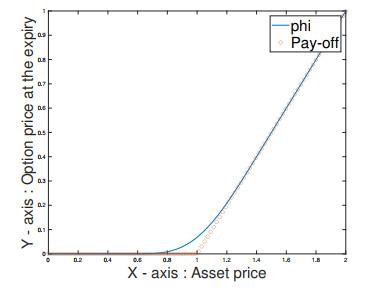









 DownLoad:
DownLoad:
